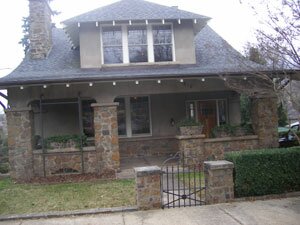REAL ESTATE- ON THE BLOCK- Rock on: Arts and crafts resplendent downtown
ADDRESS: 512 First Street
NEIGHBORHOOD: North Downtown
ASKING: $1,450,000
2006 CITY ASSESSMENT: $618,300
YEAR BUILT: 1920
SIZE: 2,986 fin. sq. ft., 400 unfin. sq. ft.
LAND: 0.38 acres
CURB APPEAL: 9 out of 10
LISTED BY: Tim Michel of McLean Faulconer 295-1131
Maybe it was because we visited this paragon of stone construction on a slate-grey, misty day. Maybe it was the haunting sound of our voices echoing from the reinforced concrete walls. Maybe it was the feeling that, like Lady Deadlock, at any moment we might hear the tapping of a ghost on the wide stone patio. Whatever the cause, while we toured this unusual example of arts and crafts architecture, nothing could banish thoughts of Bleak House.
Not to say that the house itself is bleak, by any stretch. On the contrary, thanks to glowing narrow-plank oak floors, and the extensive array of trim, closets, and built-ins of chestnut– yes, chestnut!– the rooms almost pulse with warmth. Beginning in the living room, the varnished woodwork of the window and door frames (French doors to the dining room), fireplace mantle, and gorgeous glass-front bookcases– as in all prized Arts and Crafts-style houses– is as beautiful and decorative as anything an owner could display on the walls.
A huge built-in breakfront with glass on both sides allows glimpses from the dining room into the kitchen– and it's surely one of the most unusual kitchens in town. A 1958 Daily Progress article explains that what seems to be simply au courant (these days) white subway tile surrounding the recessed stove and vent hood is actually "tile-faced brick" from the demolished Monticello Bank and Albemarle Insurance Co. With the "Lacanche" gas stove with original lights dangling above, oak panels disguising the dishwasher, and soapstone counters and sink surrounds, the whole effect is a turn-of-the-century London townhouse that Lady D. might have frequented– retrofitted for 2006.
Which introduces probably the most interesting fact about the house: many of the materials were scavenged from buildings demolished during the almost 30 years it took the builder and first resident, Edmond C. Pendleton, to create his dream. In addition to that unique tile-faced brick, the inventive Keller & George watch repairer used salvaged materials like axles from Model-T Fords to reinforce the concrete and pipes from demolition at the Albemarle County jail. (All systems, however, have now been upgraded.)
Except for the "hauling and handling of heavy materials," according to that yellowed newspaper clipping, Pendleton did all the work himself. That includes some very unusual and useful workwork. In a small breakfast room behind the kitchen, with views over the terraces to a cityscape of roofs and distant mountains, a table and benches fold down from the wall, revealing a tiny chestnut-lined cubby for condiments. And that's just one of myriad nooks and hidey-holes throughout the house: one for the mail, one for the milkman to leave the gallon of cream-on-the-top, one hiding the coal chute, two opening to reveal fold-down ironing boards, a huge built-in drawer (at least 15-feet long) about a foot from the floor in the master bedroom (what could it have been for?)– built-ins beyond built-ins, all of glorious chestnut.
Thick marble serves as windowsills in the two bathrooms, and tiny octagonal white tiles– left over from a long-ago Keller & George redo, Pendleton's widow claimed– cover the floors. New showers supplement the original tubs, and a metal medicine cabinet in the downstairs bath has been restored to its original Arts and Crafts state.
In a small closet, a temporary slate floor covers stairs to the basement so a future owner who decides to incorporate what's now a spacious separate apartment back into the house will find the transition easy. Narrow stairs lead to the second floor where the large front dormer creates an unusual front room (with huge fireplace, now gas-fired) that should be a bedroom except for the fact that it's open to the landing. Two other bedrooms and a small nursery or sewing room (with beautiful built-in storage chest, naturally) complete the upstairs.
A modern buyer might want to consider incorporating all these rooms into one huge master suite, which– with the detailing and the views– would surely rival any in town.
The grounds are just as unusual: stone everywhere, creating a pergola, a large fishpond, patios, window boxes, the terraces– and most interesting of all, a rock-studded faux stream complete with bridge and circulating pump that, alas, no one can figure out how to work. A large stone garage has been converted by the present owner (who's responsible also for all the authentic restoration inside) into a lavish artist's studio with heat, large windows, and beautiful doors.
The lot stretches down over the four levels of terracing, ending with ten income-producing parking spaces on Second street. The owner has done the necessary paperwork in the assessor's office to divide the bottom half of the property into a separate building lot, but the two parcels are not for sale separately. While the lure of hefty revenue from selling off that lot (in addition to rental income from the large two-bedroom apartment) might be inducement for someone to ink a contract at $1.45 million, we dare to hope that a new buyer will keep the land intact.
While not exactly wishing evil upon anyone, we do venture to point out that attempts to alter this glorious place for the base acquisition of filthy lucre could potentially summon the ghosts not only of Lady Deadlock herself, but Mr. and Mrs. Pendleton– and maybe even Charles Dickens for good measure. Better to let the ghosts lie, and let this gorgeous, one-of-a-kind property reign in its original resplendent glory.



Photos by Rosalind Warfield-Brown
#